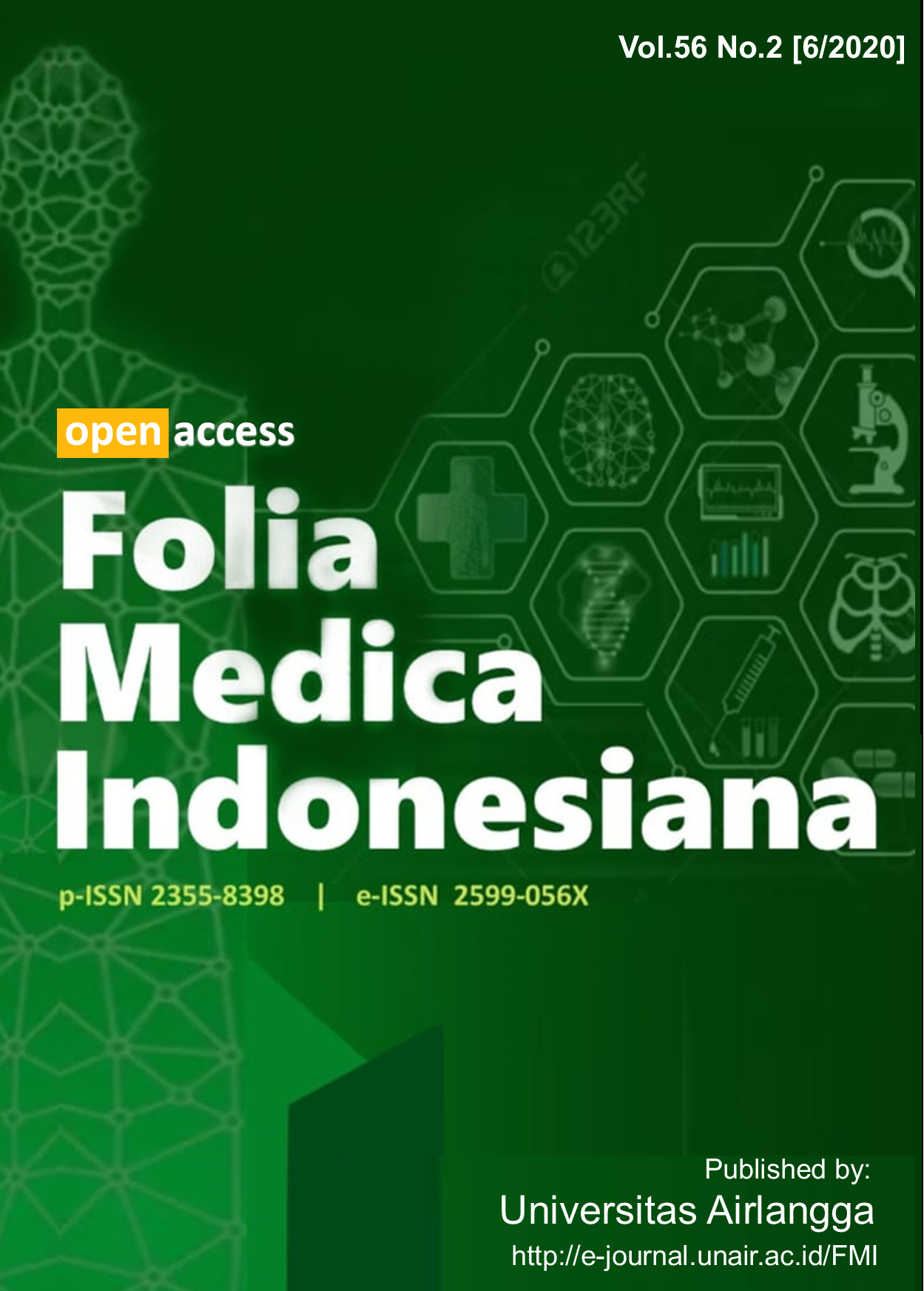Main Article Content
Abstract
Keywords
Article Details
Copyright (c) 2020 Folia Medica Indonesiana

This work is licensed under a Creative Commons Attribution-NonCommercial-ShareAlike 4.0 International License.
-
Folia Medica Indonesiana is a scientific peer-reviewed article which freely available to be accessed, downloaded, and used for research purposes. Folia Medica Indonesiana (p-ISSN: 2541-1012; e-ISSN: 2528-2018) is licensed under a Creative Commons Attribution 4.0 International License. Manuscripts submitted to Folia Medica Indonesiana are published under the terms of the Creative Commons License. The terms of the license are:
Attribution ” You must give appropriate credit, provide a link to the license, and indicate if changes were made. You may do so in any reasonable manner, but not in any way that suggests the licensor endorses you or your use.
NonCommercial ” You may not use the material for commercial purposes.
ShareAlike ” If you remix, transform, or build upon the material, you must distribute your contributions under the same license as the original.
No additional restrictions ” You may not apply legal terms or technological measures that legally restrict others from doing anything the license permits.
You are free to :
Share ” copy and redistribute the material in any medium or format.
Adapt ” remix, transform, and build upon the material.

References
- Boonstra A, van Oudenaren A, Barendregt B, et al (2000). UVB irradiation modulates systemic immune responses by affecting cytokine production of antigen-presenting cells. International Immunology 12, 1531-1538
- Burger D, Lei M, Morphet NG, et al (2006). Erythropoietin protects cardiomyocytes from apoptosis via up-regulation of endothelial nitric oxide synthase. Cardiovascular Research 72, 51-59
- Galeano M, Altavilla D, Cucinotta D, et al (2004). Recombinant human erythropoietin stimulates angiogenesis and wound healing in the genetically diabetic mouse. Diabetes 53, 2509-2517
- Hamed S, Ullmann Y, Masoud M, et al (2010). Topical erythropoietin promotes wound repair in diabetic rats. Journal of Investigative Dermatology 130, 287-294
- Haroon Z.A, Amin K, Jiang X, et al (2003). A novel role for erythropoietin during fibrin-induced wound-healing response. Am J Pathol 163, 993-1000
- Joshi D, Tsui J, Ho TK, et al (2010). Review of the role erythropoietin in critical leg ischemia. Angiology 61, 541-550
- Lapin T (2003). The cellular biology of erythropoietin receptors. The Oncologist 8, 15-18
- Li Y, Takemura G, Okada H, et al (2006). Reduction of inflammatory cytokine expression and oxidative damage by erythropoietin in chronic heart failure. Cardiovascular Research 71, 684-694
- Maiese K, Chong Z. Z, Hou J, et al (2008). Erythropoietin and oxidative stress. Curr Neurovasc Res 5, 125-142
- Paschos N, Lykissas M.G, Beris AE (2008). The role of erythropoietin as an inhibitor of tissue ischemia. Int J Biol Sci 4, 161-165
- Pradhan S, Kim HK, Thrash CJ, et al (2008). A critical role for proapoptotic protein bid in ultraviolet-induced immune suppression and cutaneous apoptosis. J Immunol 181, 3077-3088
- Raj D, Brash D.E, Grossman D (2006). Keratinocyte apoptosis in epidermal development and disease. J Invest Dermatol 126, 243-257
- Rigel DS, Weiss RA, Lim HW, et al (2004). Photoaging. Canada, Marcel Dekker Inc., p 34
- Sharples EJ, Patel N, Brown P, et al (2004). Erythropoietin protects the kidney against the injury and dysfunction caused by ischemia-reperfusion. J Am Soc Nephrol 15, 2115-2124
- Smith K. J, Bleyer AJ, Little WC, et al (2003). The cardiovascular effects of erythropoietin. Cardiovascular Research 59, 538-548
- Vorobiov M, Malki M, Schnaider A, et al (2008). Erythropoietin Prevents Dyalisis Fluid-Induced Apoptosis of Mesothelial Cells. Perit Dial Int, 28(6), 648-654
References
Boonstra A, van Oudenaren A, Barendregt B, et al (2000). UVB irradiation modulates systemic immune responses by affecting cytokine production of antigen-presenting cells. International Immunology 12, 1531-1538
Burger D, Lei M, Morphet NG, et al (2006). Erythropoietin protects cardiomyocytes from apoptosis via up-regulation of endothelial nitric oxide synthase. Cardiovascular Research 72, 51-59
Galeano M, Altavilla D, Cucinotta D, et al (2004). Recombinant human erythropoietin stimulates angiogenesis and wound healing in the genetically diabetic mouse. Diabetes 53, 2509-2517
Hamed S, Ullmann Y, Masoud M, et al (2010). Topical erythropoietin promotes wound repair in diabetic rats. Journal of Investigative Dermatology 130, 287-294
Haroon Z.A, Amin K, Jiang X, et al (2003). A novel role for erythropoietin during fibrin-induced wound-healing response. Am J Pathol 163, 993-1000
Joshi D, Tsui J, Ho TK, et al (2010). Review of the role erythropoietin in critical leg ischemia. Angiology 61, 541-550
Lapin T (2003). The cellular biology of erythropoietin receptors. The Oncologist 8, 15-18
Li Y, Takemura G, Okada H, et al (2006). Reduction of inflammatory cytokine expression and oxidative damage by erythropoietin in chronic heart failure. Cardiovascular Research 71, 684-694
Maiese K, Chong Z. Z, Hou J, et al (2008). Erythropoietin and oxidative stress. Curr Neurovasc Res 5, 125-142
Paschos N, Lykissas M.G, Beris AE (2008). The role of erythropoietin as an inhibitor of tissue ischemia. Int J Biol Sci 4, 161-165
Pradhan S, Kim HK, Thrash CJ, et al (2008). A critical role for proapoptotic protein bid in ultraviolet-induced immune suppression and cutaneous apoptosis. J Immunol 181, 3077-3088
Raj D, Brash D.E, Grossman D (2006). Keratinocyte apoptosis in epidermal development and disease. J Invest Dermatol 126, 243-257
Rigel DS, Weiss RA, Lim HW, et al (2004). Photoaging. Canada, Marcel Dekker Inc., p 34
Sharples EJ, Patel N, Brown P, et al (2004). Erythropoietin protects the kidney against the injury and dysfunction caused by ischemia-reperfusion. J Am Soc Nephrol 15, 2115-2124
Smith K. J, Bleyer AJ, Little WC, et al (2003). The cardiovascular effects of erythropoietin. Cardiovascular Research 59, 538-548
Vorobiov M, Malki M, Schnaider A, et al (2008). Erythropoietin Prevents Dyalisis Fluid-Induced Apoptosis of Mesothelial Cells. Perit Dial Int, 28(6), 648-654

